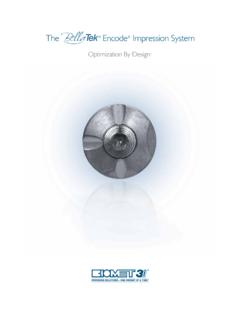Transcription of PROSTHETICS MANUAL - rawexdental.com
1 PROSTHETICS MANUALGRAND MORSETHE GRAND MORSE IMPLANT INTRODUCTION TO THE GRAND MORSE INTERFACE CLASSIFYING DENTAL IMPLANT PROSTHESIS Level of work for dental implant prostheses: implant or abutment Type of retention: cement-retained or screw-retained prosthesis Number of elements: single (crown) or multiple GENERAL CARE IN THE SELECTION OF ABUTMENTS AND PROSTHETIC COMPO-NENTS GENERAL POINTS TO BE NOTED IN THE PLACEMENT OF ABUTMENTS AND PROS-THETIC COMPONENTS Overview of Grand Morse healing abutments
2 Biological care when placing Grand Morse abutments and prosthetic components TRANSFER OF THE IMPLANT OR ABUTMENT AND MODEL PRODUCTION Transfer of implants/abutments (open or closed tray impressions) Model Production SCANNING AND DIGITAL SOLUTIONS Scan Transfer Digital workflow for prostheses (CADCAM)
3 ABUTMENT OPTIONS The implant level (screw-retained or cement-retained) Abutment level CONVENTIONAL workflow FOR PROSTHESES (LOST-WAX TECHNIQUE, TEMPO-RARY CROWNS, ETC.) OVERVIEW OF TORQUES AND CONNECTIONS GRAND MORSE ABUTMENT TRY-IN KIT GRAND MORSE PROSTHETIC KIT NEODENT TECHNIQUES One Step Hybrid
4 Distal Bar 42 BIBLIOGRAPHY INTRODUCTION TO THE GRAND MORSE INTERFACE Over the last few years, internal connections have developed an excellent reputation in implant dentistry. Implants with internal connections have begun to produce excellent clinical results and have become widely accepted by dental surgeons, thanks to their practicality.
5 Internal connections rapidly became popular soon after their introduction. They were seen to give improved biological and mechanical results1. Originally described by Stephen A. Morse in 1864, the Morse taper connection is intended to provide a more stable and reliable connection between two parts. Tapering interface adjustments then began to be commonly used in engineering practices as Morse tapers, used to connect parts of lathes2. In the dental field, the internal connections were adapted for use with dental implants, where the characteristics of this fitting, such as the forces for removal, insertion and stress distribution of the parts depend on2,3,4,5,6: 1.
6 The angle of the taper; 2. the length of the contact area; 3. the internal and external diameter of the parts; 4. the depth of insertion; 5. material properties; 6. the coefficient of friction; 7. the size and mass of the male connector. As implant connections have become increasingly important in achieving satisfactory treatment results, Neodent has developed a new implant system. The company, which has over 20 years experience in dental implants, has built a team of specialists, focused on creating a complete package of innovations based on real clinical needs.
7 The team has worked closely with the company s implant group to improve the current range of connections, creating the Grand Morse connection (Figure 1). These guidelines do not substitute each product s instructions for use (IFU). These can be found at our website: It is the surgeon s sole responsibility to analyze the most appropriate products for each clinical This innovative approach has led to a major evolution in implant design. As everything has been designed from the connection to the body of the implant, new implants have been designed to be suitable for different surgical techniques and bone density.
8 This has led to major advantages, including the fact that all Grand Morse implants (Helix GM, Drive GM and Titamax GM) have the same sized prosthetic connection, regardless of the diameter of the implant (Figure 2), with an internal angle of 16 . The thicker inner walls result in greater mechanical resistance and improved results in comparison to implants with different internal connections. They have been strategically designed for the Grand Morse 2. All Neodent Grand Morse implant connections have the same dimensions, regardless of the diameter of the implant, which results in a simpler prosthetic mm16 mmFIGURE 1.
9 The Neodent Grand Morse Implant has a deep tapering connection on the inside of the implant, which is designed to increase the contact area between the implant and the abutment. In addition, this connection has a larger diameter, resulting in a simpler, more efficient clinical mm 3. An internal hex index developed to surgically guide the placement of the implant and shape the implant during the prosthetic phase. In addition, the Grand Morse tapering connection has an indexed internal hexagonal socket called Grand Morse Exact, as shown in Figure 3.
10 Grand Morse Exact is used for the surgical positioning of the implant, giving a precise fit and orientation of the prosthetic abutments when working at the implant level. A unique feature which was developed to provide clinical solutions was the unlocking feature (self- removal function. This simple and important detail enables the removal of abutments after their placement on the implant. As the fundamental principal of tapering connections is the friction between the parts, this feature results in easier manipulation.)


